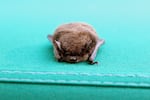Oregon researchers are embarking on a years-long study of how COVID-19 impacts wild animals in the state.
Researchers with Oregon State University aim to test about 1,600 wild animals for SARS-CoV-2, the virus that causes COVID-19.
“Right now we don’t know if there are any species that are more or less susceptible to infection, or that are infected in the state, so we’re kind of casting a really broad net,” said Brian Dolan, associate professor of immunology in OSU’s veterinary college and the study’s lead investigator.
OSU received more than $908,000 in grant funding from the U.S. Department of Agriculture for the research. Dolan and his colleagues at OSU’s Carlson College of Veterinary Medicine will focus on mammals that are likely to come into close contact with humans, including bats and rats.

2012 file photo of a brown bat at the Tillamook Forest Center
Photo courtesy of the Oregon Department of Forestry
Dolan’s team has partnered with the Oregon Department of Fish and Wildlife and wildlife rehabilitation centers across the state to collect nasal samples from animals that are brought in. Wildlife officials already test wild animals for infectious diseases, mostly rabies. Grant funding will go toward adding SARS-CoV-2 tests. Those tests will be similar to the nasal swabs that humans use.
With these samples, researchers can sequence the virus’s genome to see if it recently migrated from humans or if it had spread through different animal populations.
“Our overall goal is to determine if the virus is present in different wild animal populations throughout the state, and if it is, to determine how long the virus has been circulating within these populations,” Dolan said.
Not a lot is known about how COVID-19 impacts wild animals. Biologists have determined that it can spread and mutate among white-tailed deer, and the USDA has detected it among mink and mule deer. The virus has also been found in more than 100 dogs and cats, as well as several zoo animals, including tigers, lions and gorillas.
Part of the researchers’ concern is whether the virus could mutate among animal species, and then spread back to humans. Dolan said the chances of that are slim but worth keeping an eye on.
OSU researchers aim to complete the study by spring 2025.
